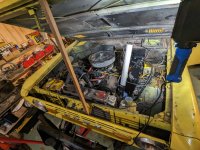- Joined
- Feb 21, 2015
- Messages
- 29
Thanks so much for this information. I was beating my head against the wall, feeling like an idiot for not knowing what is going on, assuming I had done something incorrectly... And all the above. I repeatedly tried to bleed the system as others would say and it would suck it down to far, too quickly or the bubbles would be too close and just get sucked in and perpetuate the issue. Then I'd shut it off and the air would expand and it would literally shoot out of the engine bay and on to ... My nice new jacket that I unwittingly put in the way and onto all sorts of other things I don't wish to have power steering fluid on.Worst "simple" job on a Bronco is cracking open the power steering system. lol
Add a hyd ram and unless you crack the fittings on the ram to bleed it AT the ram you can easily double the time.
I learned a trick that works and it has cut my time 4 fold or sometimes an entire day (or two). The key for all of us is to get the air moved out of the pockets in the system so the bubbles will get out the reservoir w/o damage to the pump. Release the trapped air!
Go through all the steps w/o starting but when you do start the engine you need a large reservoir because physics says air compresses and liquids don't.
So when you start the engine the reservoir level drops severely and often it drops low enough (because the air is compressing and therefore taking up less volume) that you will introduce more air into the system compounding the bleeding of the system. Even if you fill the reservoir to the very top it still does this- often.
What I learned from a Nat' Brake supplier (Master Pwr Brakes) is this: they don't do 1/10th of what we all do to bleed the system. They make an extension for the vehicles reservoir and fill it up. Start the rig and the air gets compressed, moves thru the system to the reservoir so the bubbles can escape and because the reservoir is so large you never introduce any more air. Boom- done.
I tried this and it works. I use a caulder coupler around my large PSC reservoir and a pc of 3" PVC pipe that is appr 15" long. No leaks.
I fill the PVC pipe with ps fluid, go thru my left turn, right turn back and forth a couple dozen times with the wheels of course off the ground. Start the rig and with someone there with a LARGE opening on a can of ps fluid (so it will pour fast) and then start the engine. The fluid will probably drop a foot- have your buddy FILL IT AS IT DROPS.
Let the engine run for 30 seconds w/o input. Shut it off for 10 min or until bubbles quit surfacing. Do this until no more bubbles. Then with the engine running go l to r without stalling on the full turn bump stops on either side- important. No more bubbles you are done. Should take 30 min.
Syphon off the extra qt of fluid out of the PVC pipe extension (clean fuel hose or turkey baster) so when you disconnect the caulder coupler you won't spill any fluid.
Done w/o pwr strg fluid burped all over your engine.
Shops can't afford to have their customers cars sitting and waiting for bubbles to bleed out for days on end. MP Brakes told me years ago they just start out by starting the engine and pouring fluid in. I still introduce some of the "basic steps" that I've done and others mentioned on this list since it still seems "right". Maybe because I've been doing it that way since HS.
I put the extension tube on( just a PVC flexible adapter with hose clamps on it hooked up to 1- 1/2' of 2"PVC)(attached picture of set up) Did the same steps for bleeding as you said and after a few cycles it doesn't make any noise and no more bubbles... Like at all.
Lowered the truck and it turns the tires so easily that I thought it must still be off the ground but it wasn't. So I'm "pumped".












